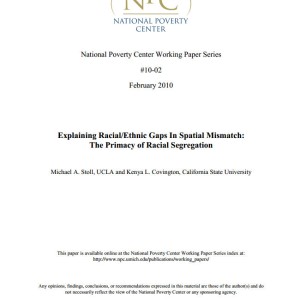
Authors: Michael A. Stoll, Kenya L. Covington
Date: February 1, 2010
Project: [wpv-post-link id=”$project”]
Despite declines in racial segregation across most U.S. metropolitan areas in recent years, racial and ethnic minorities still display uneven geographic access to jobs. In this article, we provide a detailed analysis of the factors driving racial and ethnic gaps in spatial mismatch conditions across U.S. metropolitan areas. Using data primarily from the 1990 and 2000 U.S. Census, and the 1994 and 1999 Economic Census and the Zip Code Business Pattern files we generate descriptive, multivariate, and decompositional evidence to address why blacks and to a lesser extent Latinos display greater degrees of spatial mismatch than whites. The results indicate that racial segregation in housing markets among many other factors including job sprawl, is the most important factor. Our models indicate that racial differences in spatial mismatch conditions, particularly between blacks and whites, should be eliminated in 45 to 50 years should racial segregation levels continue to decline in the future at similar rates observed over the 1990s
Link to Publication